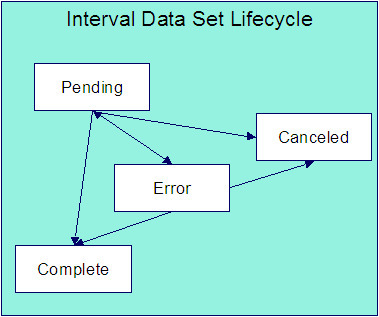Life Cycle of Interval Profile Data Sets
The following diagram shows the possible lifecycle of an interval profile data set.

Pending Use this status for data, added to the system, that requires validation to occur before it is available for further processing. Validation is handled through an algorithm linked to the profile type for this data set's profile. Refer to Setting Up Interval Profile Types for more information. When creating a data set, the system automatically sets the status to Pending when the profile type indicates a validation algorithm or if an interval profile has not been identified.
Canceled A user can cancel a Pending or Error data set if the data set should not be used for further processing. Refer to Interval Data Maintenance for more information. Additionally, algorithms may be designed to cancel data sets in certain situations.
Error A validation or derivation algorithm may set this status for a data set if it detects an error condition. Data sets in this status are also written to the Interval Data Exception table. Refer to How To Correct a Data Set in Error. When a validation error has been corrected, change the status of the data set back to Pending so it will be reprocessed.
Complete Only complete data sets are used by rate application and derivation algorithms. If data being added to the system has already been validated, it may be uploaded to the system in this status. Data derivation algorithms may create a data set in Complete status or change the status of a data set to Complete if no error conditions are detected. Data validation algorithms may change the status of a data set to Complete if no error conditions are detected. When creating a data set, the system automatically sets the status to Complete when the profile type for the interval profile does not indicate a validation algorithm.
A data set is created either in Pending status or Complete status, depending on the existence of a validation algorithm on the profile type. A user can cancel a dataset. Other status changes may depend on how your validation and creation algorithms are written.
- The base validation algorithm only processes Pending data sets. As a result, a user is expected to change the status of an error data set back to pending when the error condition has been fixed. When the data is clean, the algorithm changes the status to Complete.
- The base creation algorithms automatically delete any Error data sets and start over in an attempt to produce a Complete data set. This is similar to the billing process, which deletes error bill segments and tries from the beginning to produce an error free segment. Another alternative is for a user to Cancel any data sets in Error to keep a record of the incorrect data.
For more information about data derivation and validation algorithms, refer to Setting Up Interval Profile Types.
